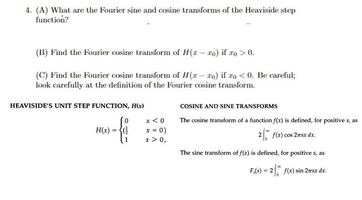Hi all, I am struggling with the following problem on the Fourier sine and cosine transforms of the Heaviside unit step function. The definition I have been used are provided below as well. I tried each part of the problem, but I'm only left in terms of limits as x -> infinity of sin or cos function, which are undefined. How do I approach this? Am I totally off track and missing some key properties of these transforms? Sorry for the poor formatting...any help appreciated.
Problem and definitions:

Attempt at a solution attached
Problem and definitions:

Attempt at a solution attached


